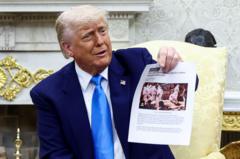In a striking display of diplomatic ballet, South Africa’s President Cyril Ramaphosa met with U.S. President Donald Trump, who leveraged the occasion for a pointed critique of the South African situation. The encounter, held three months into Trump's second term, underscored the unpredictable nature of high-level engagements, particularly when the U.S. President's provocative style aligns with political objectives at home.
During their meeting, after exchanging pleasantries, Trump deftly shifted the focus to sensitive narratives surrounding “white genocide” in South Africa. When prompted by a journalist, Ramaphosa emphasized a need for Trump to “listen to the voices of South Africans,” before the U.S. President orchestrated a dramatic display by asking for the lights to be dimmed. A video presentation followed, targeting the alleged persecution of white farmers in South Africa—an assertion that has met with fierce criticism and skepticism.
The video featured inflammatory content, including activists chanting contentious slogans from South Africa’s past. Yet Trump’s assertions clashed with the facts, particularly regarding local governance capabilities over land confiscation policies, which Ramaphosa had previously signed but were yet to be enforced.
Remarkably, the dynamic shifted as Ramaphosa brought two esteemed South African golfers—Ernie Els and Retief Goosen—into the mix. Their presence lightened the mood yet also provided a strategic layer, serving as a symbolic defense against Trump’s aggressive line of questioning. The South African President invoked their presence, suggesting if there was genuine persecution of Afrikaners, such figures would not be present for the talks.
Throughout the encounter, however, Ramaphosa maintained a composed demeanor, refraining from engaging in the provocations, while Trump's rhetoric aimed squarely at resonating with his domestic constituency—amplifying concerns that cater to a base that thrives on perceptions of grievances.
Despite the drama, Ramaphosa's responses appeared calculated, prioritizing stability in U.S.-South Africa relations over engaging in contentious dialogue. As he navigated through accusations, the South African leader left the session unscathed, indicating his readiness to handle the unpredictable nature of high-stakes diplomacy with poise.
While Trump's approach continues to shape perceptions of foreign relations, it raises questions about the effectiveness of such theatrics in fostering genuine dialogue. Moving forward, as leaders adapt to evolving diplomatic landscapes, Ramaphosa's endurance serves as a testament to the intricate balance required in modern diplomatic exchanges.
During their meeting, after exchanging pleasantries, Trump deftly shifted the focus to sensitive narratives surrounding “white genocide” in South Africa. When prompted by a journalist, Ramaphosa emphasized a need for Trump to “listen to the voices of South Africans,” before the U.S. President orchestrated a dramatic display by asking for the lights to be dimmed. A video presentation followed, targeting the alleged persecution of white farmers in South Africa—an assertion that has met with fierce criticism and skepticism.
The video featured inflammatory content, including activists chanting contentious slogans from South Africa’s past. Yet Trump’s assertions clashed with the facts, particularly regarding local governance capabilities over land confiscation policies, which Ramaphosa had previously signed but were yet to be enforced.
Remarkably, the dynamic shifted as Ramaphosa brought two esteemed South African golfers—Ernie Els and Retief Goosen—into the mix. Their presence lightened the mood yet also provided a strategic layer, serving as a symbolic defense against Trump’s aggressive line of questioning. The South African President invoked their presence, suggesting if there was genuine persecution of Afrikaners, such figures would not be present for the talks.
Throughout the encounter, however, Ramaphosa maintained a composed demeanor, refraining from engaging in the provocations, while Trump's rhetoric aimed squarely at resonating with his domestic constituency—amplifying concerns that cater to a base that thrives on perceptions of grievances.
Despite the drama, Ramaphosa's responses appeared calculated, prioritizing stability in U.S.-South Africa relations over engaging in contentious dialogue. As he navigated through accusations, the South African leader left the session unscathed, indicating his readiness to handle the unpredictable nature of high-stakes diplomacy with poise.
While Trump's approach continues to shape perceptions of foreign relations, it raises questions about the effectiveness of such theatrics in fostering genuine dialogue. Moving forward, as leaders adapt to evolving diplomatic landscapes, Ramaphosa's endurance serves as a testament to the intricate balance required in modern diplomatic exchanges.






















